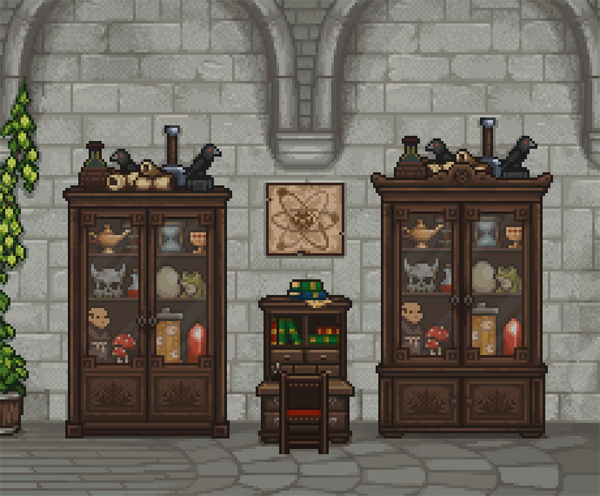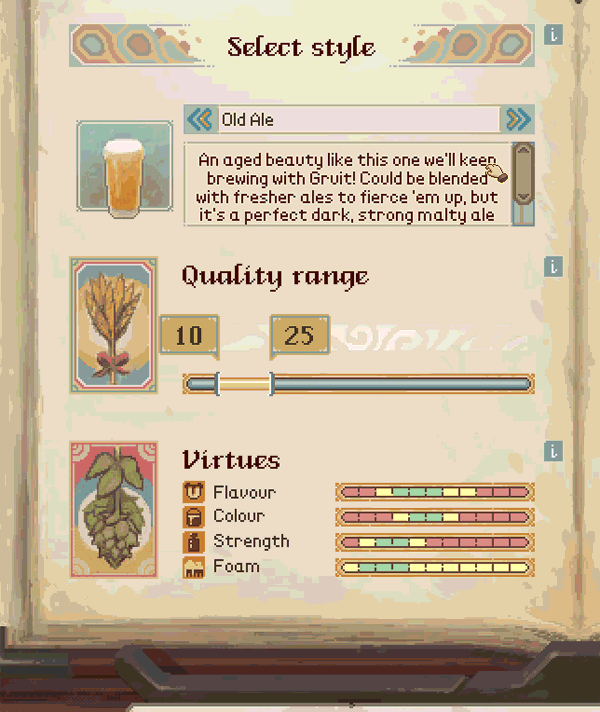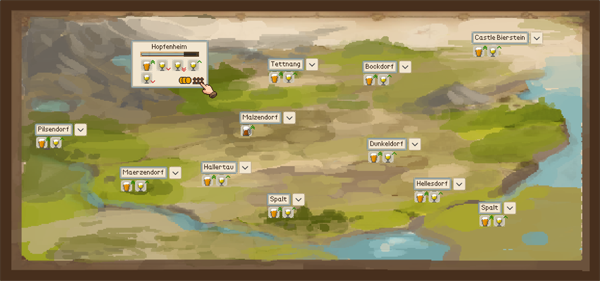We kept the momentum going for many of the things we have been working on these past couple of weeks, but as you're about to witness, we did move the progress bar quite a bit.
All in all, yet another busy week in Hammer & Ravens, with some new additions, new directions, some animated cursors flying about... the whole shebang.
Read on ;)
-- A larger map appears!
A map of your monastery's surrounding area? Hmmm...
In a previous post, we briefly hinted at the possibility of surrounding villages and thus a more active role of their markets in Ale Abbey's economy. Well, we did ruminate on the idea this past week and made some progress...
Although rudimentary, the screenshot above is a small test of visuals that will help us understand other UI necessities as well as the deeper intricacies of the mechanic; multiple villages, multiple names, market details and preferences, and how to plot everything on a map that makes sense - of course.
Having accrued quite the experience creating a very intricate and interdependent map in a previous game we developed (Empires in Ruins) we were initially a little skeptical, if not intimidated, as to the level of depth that would make sense for Ale Abbey... THANKFULLY, it won't be as painful to complete!
-- The Cabinet of Curiosities
Although we love talking about the furniture available in Ale Abbey, we hardly ever used an entire spot in our weekly Something's Brewing for one, singular piece.
But we have a special place in our heart for the Laboratorium and it seems that everything we prepare for this room immediately oozes character. So we give you our favorite most peculiar piece of furniture in the Abbey (for the time being), the Cabinet of Curiosities!

Used to potentially provide certain bonuses (TBD), Yannis is still pushing for some more easter eggs... Oh, yeah, did we forget to mention it already has one?
-- In-game cursor update
For those of you who remember, last week we managed to finalize the decision on what cursor to use for Ale Abbey. This of course means that this week would have been spent testing it, which we did, happily.

Do not judge from the quality of the gif, and do not consider this anywhere close to being done ;) WIP!
There are of course way more parameters to be considered (relative sizes, speeds, options, etc.), anything to make it more fluid and pleasant to the eye, so the promise of further testing is easy to make. More to come.
-- Can one use old techniques in today's homebrewing?
Modern brewing equipment and techniques offer convenience and consistency. There is no doubt about that. Especially when one has to do with homebrewing at an amateur level, the initial lack of know-how is easily covered by the available equipment and techniques of today.
But... reverting to older techniques for the sake of the charm and (potentially) unique flavors that come from using them is a call usually answered by those who like to raise the difficulty levels in their hobbies. Embracing traditional methods can be quite daunting, but it can also bring a new dimension to the brewing experience and offer a deeper connection to the craft's rich history.
So, we have 3 classic techniques you might want to experiment with:
- Open Fermentation. Historically, beer was often fermented in open vats, allowing natural wild yeasts and bacteria to influence the brew. While riskier due to the potential for contamination, open fermentation can produce complex and distinctive flavors, particularly in styles like farmhouse ales and Lambics. To safely experiment with open fermentation today, you can go for a sanitized, temperature-controlled environment and start with smaller batches to minimize risk.
- Decoction Mashing. This involves removing a portion of the mash, boiling it, and then returning it to the main mash to raise the overall temperature. Far more labor-intensive (and thus largely replaced by single-infusion mashing), it can add a rich malt character and enhanced body to lagers and other traditional styles.
- Wooden Vats. Commonly made from oak, wooden vats were the standard in brewing before the advent of stainless steel fermenters. These vats could impart unique flavors and aromas to the beer, derived from the wood itself and the microflora residing within it. Because of the learning curve in their overall maintenance (and the potential of losing a small fortune experimenting with them), starting with smaller oak barrels or wooden fermentation vessels can offer a manageable way to explore the depth and complexity that wood aging brings to beer.
Yannis wanted to talk about Kräusening, AGAIN, but for Emiliano's sake, he didn't. If you were looking for new ways to challenge yourself, one of the techniques above, (or all three!), is still a good way to re-ignite your passion for the hobby!
Remember to enjoy your weekend responsibly, and join us next week for some more Ale Abbey news!
-- Hammer & Ravens
Craving for more Ale Abbey? Or maybe you want to chat with the team and our community? Find us on:






